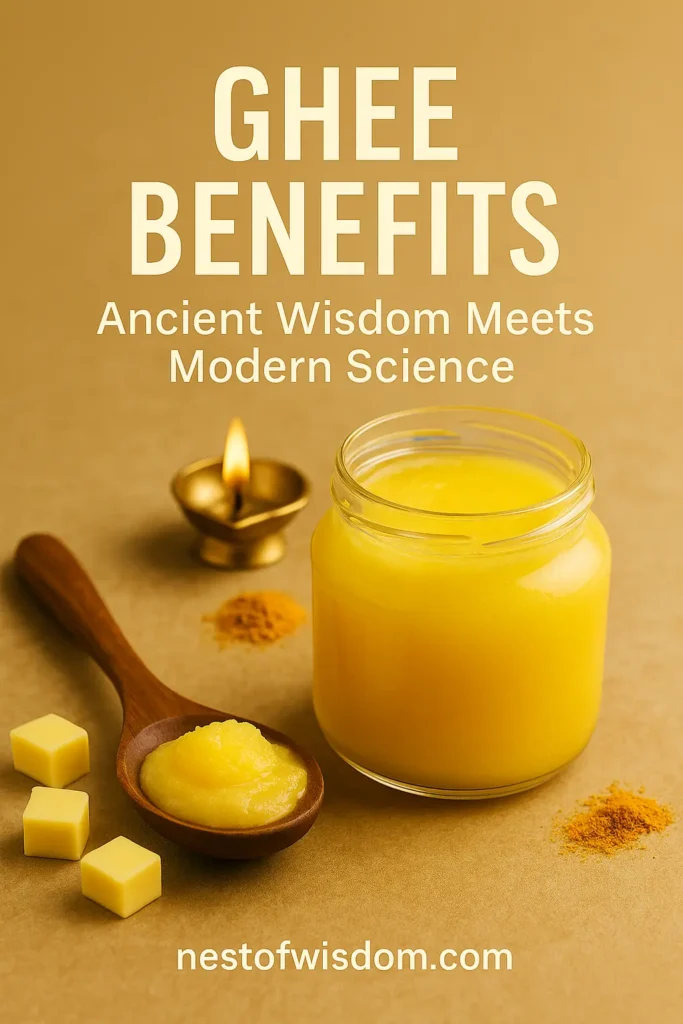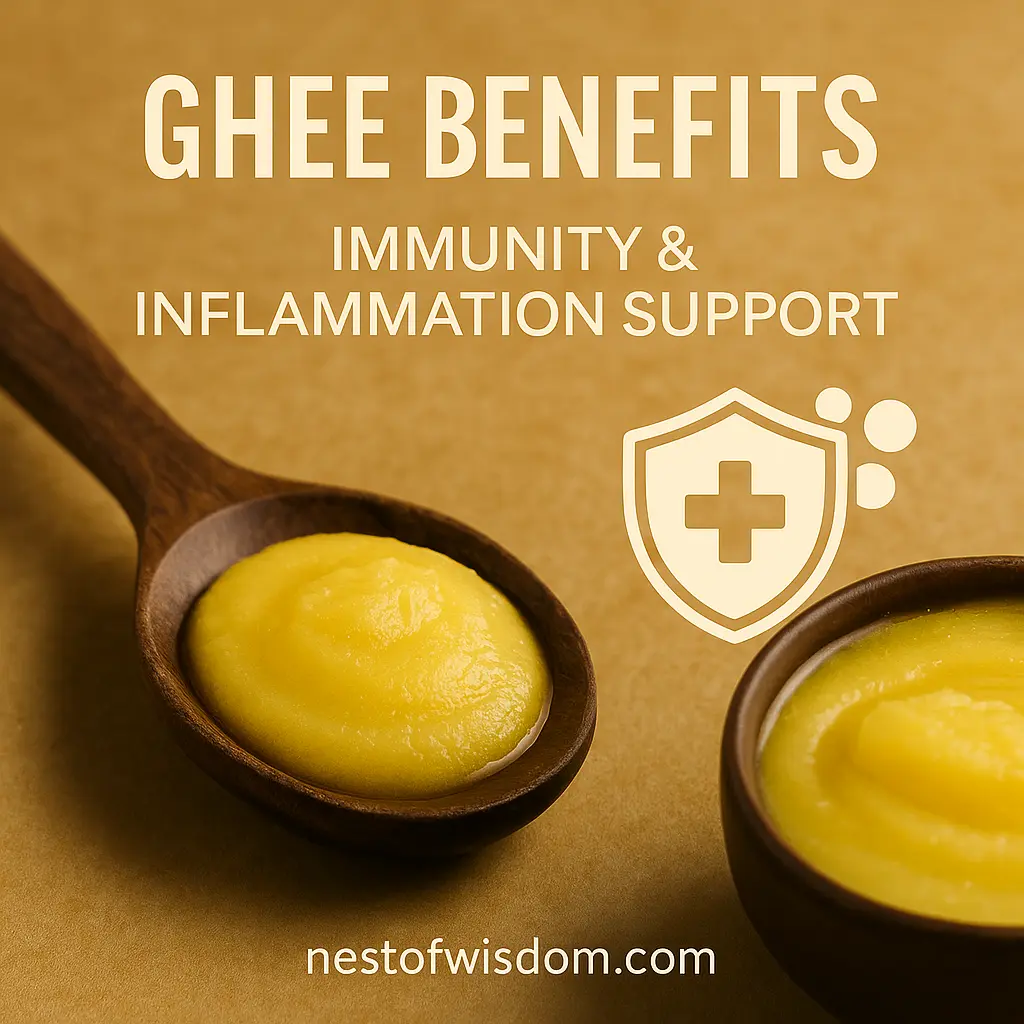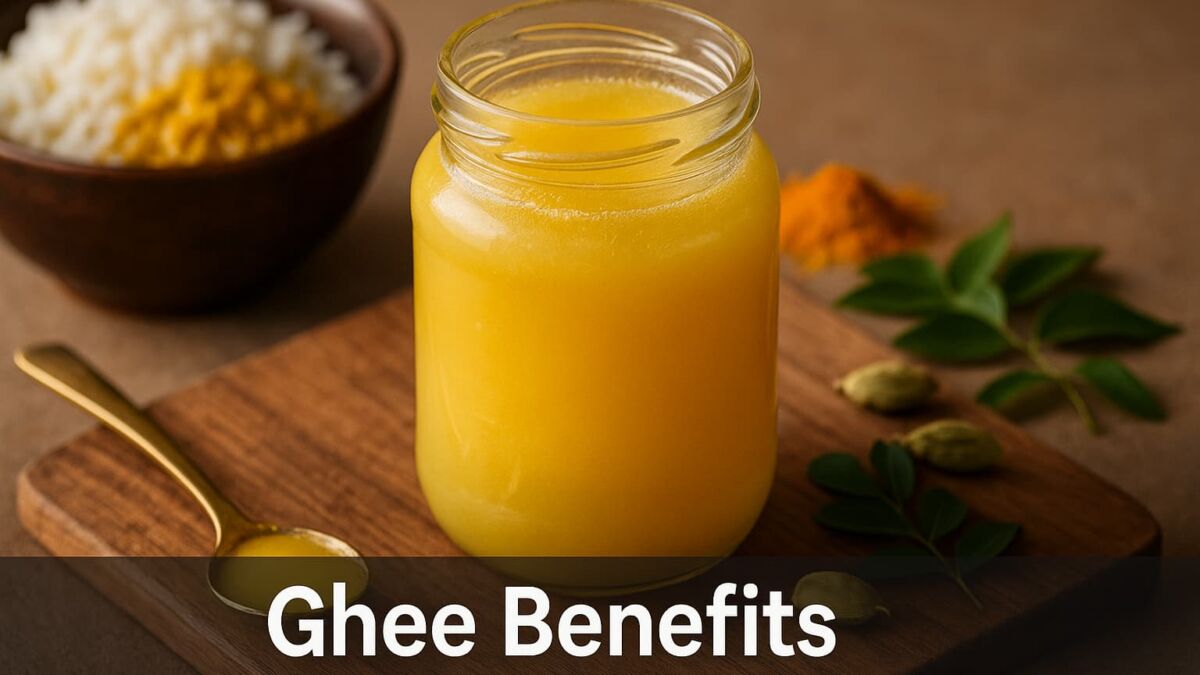Table of Contents
- Introduction: The Golden Essence of Health
- What is Ghee?
- Ancient Tamil & Ayurvedic Uses
- Nutritional Composition of Ghee
- 1. Ghee Benefits for Digestion
- 2. Ghee Benefits for Cardiovascular Health
- 3. Ghee Benefits for Brain Function & Mental Clarity
- 4. Ghee Benefits for Immunity & Inflammation
- 5. Ghee Benefits for Skin & Hair
- 6. Ghee Benefits for Weight Management & Metabolic Health
- How Much Ghee Per Day? (Serving Sizes)
- Ghee Benefits in Cooking: Smoke Point & Best Uses
- How to Make Ghee at Home (Quick Guide)
- Lactose, Casein & Dairy Sensitivities
- Shelf Life & Storage Science
- Flavor, Pairing & Everyday Uses
- Ghee vs Butter vs Oils (Quick Comparison)
- Who Should Limit or Avoid Ghee
- Common Myths & Facts
- How to Spot Rancidity
- Cost & Portion Control Tips
- Real-Life Case Studies
- How to Choose Quality Ghee
- Precautions & Considerations
- Conclusion: A Return to Golden Simplicity
- Related Guides
- FAQ
- References
Introduction: The Golden Essence of Health


For thousands of years, ghee has been celebrated in Tamil kitchens and Ayurvedic practice for nourishment, ritual, and healing. Today, modern research increasingly supports what elders knew—Ghee Benefits span digestion, immune balance, cognition, skin health, and culinary versatility. This guide highlights practical ways to realize those Ghee Benefits in everyday cooking.
What is Ghee?
Ghee is clarified butter made by simmering unsalted butter until water evaporates and milk solids separate. The clear, aromatic fat that remains is strained, producing a shelf-stable cooking fat with a high smoke point (≈250°C), a nutty flavor, and minimal lactose/casein—key reasons many people pursue Ghee Benefits over regular butter.
🌿 Tamil Insight: “நெய் உடலை வலிமையாக்கும், மனதை தெளிவாக்கும்.” (Ghee strengthens the body and clarifies the mind.)
Ancient Tamil & Ayurvedic Uses
- Mixed into rice, millets, and dal to support comfortable digestion
- Post-partum recipes for strength and recovery in Tamil households
- Ghrita (medicated ghee) as an Ayurvedic carrier for herbs
- Offered in lamps and rituals for purity and auspiciousness
In Ayurveda, ghee is considered sattvic: it supports clarity, memory, and vitality—cornerstones often cited among traditional Ghee Benefits.
Nutritional Composition of Ghee
- Butyrate (SCFA): Feeds colon cells, supports gut barrier integrity
- CLA (Conjugated Linoleic Acid): Studied for metabolic and anti-inflammatory roles
- Vitamins A, D, E, K: Fat-soluble micronutrients for immunity, bone health, antioxidant defense
- Omega-3s (small amounts): May help temper inflammatory responses
These components explain many widely discussed Ghee Benefits.
1. Ghee Benefits for Digestion


Butyrate naturally present in ghee supports a healthy colon environment, promotes a calm gut, and pairs well with fiber-rich staples for steady energy—one of the most practical Ghee Benefits people notice first.
How to Use: Stir 1 tsp into hot rice, millet, or dal; temper spices in ghee for improved aroma and digestibility.
2. Ghee Benefits for Cardiovascular Health


Used in moderation and as a swap for ultra-processed fats, ghee can fit a heart-conscious pattern. Framed this way, potential Ghee Benefits include better meal satisfaction and reduced reliance on refined oils.
How to Use: 1–2 tsp per meal in place of refined seed oils, factoring in your daily fat targets.
3. Ghee Benefits for Brain Function & Mental Clarity


In Ayurveda, ghee is a medhya rasayana—a tonic for mind and memory. Nutrient-dense fats and fat-soluble vitamins help nourish the nervous system, one reason many associate Ghee Benefits with calm focus.
How to Use: A teaspoon in warm milk at night (or golden milk with turmeric) can be soothing.
4. Ghee Benefits for Immunity & Inflammation


Antioxidants and vitamins in ghee, together with butyrate’s gut-immune link, support balanced inflammatory responses—another area where people cite tangible Ghee Benefits when shifting from ultra-processed fats.
How to Use: Temper spices (cumin, mustard, ginger) in ghee to build flavor and digestibility.
5. Ghee Benefits for Skin & Hair
Topical ghee has long been used for dryness and minor irritation. Its Vitamin E and lipids help restore moisture and comfort, contributing to traditional external Ghee Benefits.


Skin
- Softens dry areas
- Soothes mild irritation
- Comforts minor kitchen burns
Hair
- Adds shine and slip
- Nourishes scalp
- Helps reduce breakage
Topical Use: Warm slightly, apply for 20–30 minutes, then rinse.
6. Ghee Benefits for Weight Management & Metabolic Health
Swapping ultra-processed fats for a measured amount of ghee can improve meal satisfaction, which may reduce overeating. Pair ghee with fiber and protein for steady glucose responses—an often overlooked angle of Ghee Benefits. Total calories still rule outcomes, so measure portions.
How Much Ghee Per Day? (Serving Sizes)
- General: 1–3 tsp/day for most healthy adults, within calorie needs
- Active lifestyles: May allow slightly more within macros
- Medical conditions: Personalize with a clinician/dietitian
Ghee Benefits in Cooking: Smoke Point & Best Uses
- High heat: Stir-fries, tadka/tempering, shallow fry
- Medium heat: Sauté vegetables, eggs, grains
- Finishing: Drizzle over khichdi, poriyal, steamed greens
Pro tip: Bloom spices in ghee to unlock fat-soluble flavors—one of the culinary Ghee Benefits you can taste instantly.
How to Make Ghee at Home (Quick Guide)
- Melt 500 g unsalted butter on low in a heavy pot.
- Simmer gently; foam rises, then milk solids sink and brown.
- When liquid turns clear and smells nutty, switch off heat.
- Strain through fine mesh/cheesecloth into a clean glass jar.
- Cool, seal, and store away from light and moisture.
Lactose, Casein & Dairy Sensitivities
Because milk solids are removed, ghee is typically very low in lactose and casein. Many with lactose intolerance tolerate it, making this one of the accessibility-focused Ghee Benefits. Those with severe dairy allergy should consult an allergist and trial cautiously.
Shelf Life & Storage Science
- Why shelf-stable? Minimal water + removal of milk solids reduces microbial growth.
- Room temperature: Store sealed, cool, and dark. Always use a dry spoon.
- Refrigeration: Extends aroma and freshness in warm climates.
- Avoid: Moisture, repeated heating/cooling cycles, and direct sunlight.
Good storage preserves flavor and protects the nutritional Ghee Benefits.
Flavor, Pairing & Everyday Uses
- Breakfast: Temper cumin + curry leaves in ghee; toss into upma, poha, or millets.
- Lunch: Finish dal, sambar, or rasam with ½ tsp ghee for mouthfeel.
- Dinner: Sauté greens (spinach, moringa leaves) in ghee + garlic/ginger.
- Sweets: Drizzle over payasam or kheer; toast nuts in ghee for prasad.
These quick ideas turn theoretical Ghee Benefits into daily habits.
Ghee vs Butter vs Oils (Quick Comparison)
| Feature | Ghee | Butter | Refined Seed Oils |
|---|---|---|---|
| Smoke point | High (~250°C) | Lower (~175°C) | Varies (often high) |
| Milk solids | Removed | Present | None |
| Flavor | Nutty, aromatic | Creamy, dairy | Neutral |
| Processing | Traditional, minimal | Minimal | Often highly refined |
This side-by-side helps explain why cooks seeking specific Ghee Benefits choose it over butter or refined oils.
Who Should Limit or Avoid Ghee
- Elevated LDL/CVD risk—use sparingly and with clinician guidance
- Severe dairy allergy—may react to trace proteins
- Very low-fat therapeutic diets—follow professional advice
Personalizing intake ensures you capture Ghee Benefits safely.
Common Myths & Facts
- Myth: “Ghee is automatically heart-healthy in any amount.”
Fact: Portion size and overall diet quality matter most for genuine Ghee Benefits. - Myth: “All ghee is the same.”
Fact: Method, feed, and freshness influence aroma and micronutrients. - Myth: “Ghee contains lots of lactose.”
Fact: Properly clarified ghee is very low in lactose and casein.
How to Spot Rancidity
- Smell: Paint-like, soapy, or sharp odors
- Taste: Bitter or waxy aftertaste
- Look: Unusual dark specks, moisture pockets, or separation
Discard rancid jars—freshness preserves flavor and practical Ghee Benefits.
Cost & Portion Control Tips
- 1 level teaspoon ≈ 5 g ≈ ~45 kcal—measure with a spoon to avoid overpouring.
- A jar lasts longer when used for tempering and finishing rather than deep frying.
- Batch-make tadka in ghee; refrigerate in a small jar for quick flavor boosts.
Smart portions help you enjoy Ghee Benefits without overshooting calories.
Real-Life Case Studies
Case Study 1: Postpartum Recovery
Background: Daily ghee-infused meals during early recovery. Outcome: Better comfort with meals, steady energy, improved mood—how traditional Ghee Benefits show up at home.


Case Study 2: Digestive Calm
Background: 35-year-old with acidity added 1 tsp ghee to warm meals. Outcome: Less bloating; smoother digestion in 3 weeks—simple habits, real Ghee Benefits.
Case Study 3: Skin Comfort
Background: Topical ghee for a minor kitchen burn. Outcome: Moisture comfort and minimal dryness while healing.
How to Choose Quality Ghee


- Grass-fed, organic when possible (richer aroma/micronutrients)
- Traditional slow-cook methods; clean filtration
- Glass jars and tight lids for freshness
- Label tips: Avoid added flavors or vegetable oils; look for batch date.
Storage: Keep sealed, cool, and dark; refrigerate in hot/humid climates.
Precautions & Considerations
Ghee is calorie-dense. Most people with lactose intolerance tolerate it, but those with severe dairy allergy should be cautious. If you have high LDL or heart disease, use sparingly and seek individualized guidance so the Ghee Benefits you want align with your health goals.
Conclusion: A Return to Golden Simplicity
Ghee Benefits bridge tradition and modern cooking. When used mindfully—swapping ultra-processed fats, measuring portions, and pairing with whole foods—ghee can support digestion, calm focus, glowing skin, and deeply satisfying flavors. Keep a small jar on the counter as a daily reminder to cook with intention and enjoy simple, sustaining Ghee Benefits.
🌿 தமிழ் நினைவில் வையுங்கள்: “நெய் உணவின் ஆனந்தம், உடலின் ஆரோக்கியம்.” (Ghee brings joy to food and strength to the body.)
Related Guides
FAQ
Is ghee lactose-free?
Properly clarified ghee is very low in lactose and casein. People with lactose intolerance usually tolerate it; those with severe dairy allergy should consult a clinician. This is one of the practical Ghee Benefits for sensitive eaters.
Does ghee raise cholesterol?
Portion size matters. Used moderately and as a swap for ultra-processed fats, ghee can fit heart-conscious patterns. If you have lipid concerns, get individualized advice to pursue Ghee Benefits safely.
How much ghee per day is okay?
For most healthy adults, 1–3 teaspoons per day within calorie needs. Adjust for goals, activity, and medical guidance.
Is ghee good for high-heat cooking?
Yes. Ghee’s high smoke point (~250°C) suits sautéing and tempering—culinary Ghee Benefits you’ll appreciate immediately.
Can I use ghee during fasting?
Depends on the fasting type. In many cultural fasts, small amounts are allowed. For therapeutic fasts, follow your practitioner’s protocol.
References
- World Journal of Gastroenterology — Butyrate in gut health and digestion
- Indian Journal of Medical Research — Effect of ghee consumption on serum lipid levels
- International Journal of Ayurvedic Medicine — Medhya Rasayana & mental clarity
- Ancient Science of Life — Ghee in Ayurvedic wound-healing preparations
Nest of Wisdom Insights is a dedicated editorial team focused on sharing timeless wisdom, natural healing remedies, spiritual practices, and practical life strategies. Our mission is to empower readers with trustworthy, well-researched guidance rooted in both Tamil culture and modern science.
இயற்கை வாழ்வு மற்றும் ஆன்மிகம் சார்ந்த அறிவு அனைவருக்கும் பயனளிக்க வேண்டும் என்பதே எங்கள் நோக்கம்.
- Nest of Wisdom Authorhttps://nestofwisdom.com/author/varakulangmail-com/
- Nest of Wisdom Authorhttps://nestofwisdom.com/author/varakulangmail-com/
- Nest of Wisdom Authorhttps://nestofwisdom.com/author/varakulangmail-com/
- Nest of Wisdom Authorhttps://nestofwisdom.com/author/varakulangmail-com/
Related posts
Today's pick
Recent Posts
- Internal Linking Strategy for Blogs: A Practical, Human-Centered Playbook
- AI in the Automotive Industry: A Practical, Human-Centered Guide
- Cloud Tools for Small Businesses and Freelancers: The Complete Guide
- Generative AI in Business: Real-World Use Cases, Benefits & Risks
- 7 Life-Changing Daily Habits for Weight Loss Without Dieting

